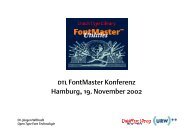DTL FontMaster Manual1.1 PDF
DTL FontMaster Manual1.1 PDF
DTL FontMaster Manual1.1 PDF
Create successful ePaper yourself
Turn your PDF publications into a flip-book with our unique Google optimized e-Paper software.
dtl ikarusmaster: outline description<br />
Outline Description<br />
The outlines of the glyphs in the font are described by the Ikarus format.<br />
The ik format describes an outline by either straight lines or a Cubic spline<br />
section, which is also a third-degree polynomial. Every point of the Ikarus<br />
format lies exactly on the contour -in contrast to the Bezier format, where<br />
control points are located outside the contour. Therefor the ik format is<br />
ideal for working with a digitzing tablet for input.<br />
For a long time the Ikarus format has been the de facto standard for<br />
creating and manipulating digital fonts, and is still in use worldwide by<br />
specialist type design houses. These demanding customers appreciate the<br />
high quality of the digital data combined with the system’s flexibility, its<br />
simplicity and the speed with which fonts can be digitized, edited and<br />
converted into other data formats.<br />
Four diuerent type of point are available to mark the contours:<br />
1. Start points: only one start point for each contour is allowed. The<br />
ideal location for a start point is at a corner. If there are no corner<br />
points on the contour, the second best location is at the first (in<br />
clockwise order) of two adjacent tangent points. If there are neither<br />
corner nor tangent points, the start point should be placed at an<br />
extreme curve point. Start points are marked in red by default.<br />
2. Curve points: describe curved sections of the contour, by default<br />
marked in dark blue.<br />
3. Corner points: marking a non-continuous transition between two<br />
straight sections, two curve sections or a curve and a straight line.<br />
4. Tangent points: These points are marking a continuous tangential<br />
transition from a straight line to a curve and vice versa. They are<br />
marked in light blue by default.<br />
120<br />
Curve point<br />
Start point (corner point)<br />
Tangent point<br />
note: The ik file format is<br />
considered as a database<br />
format. Currently one file<br />
can contain up to 22000 glyphs.<br />
Glyphs are identified by 2-byte<br />
numbers (1–65535). The data<br />
consists of header, contour header<br />
and outline. There is no hinting<br />
information in the data. For<br />
PostScript Type 1, TrueType and<br />
OpenType production additional<br />
information is necessary and has<br />
to be supplied via text files, like<br />
ufm, afm, etc. (more info about<br />
these text files can de found in the<br />
appendices).<br />
The format specification is<br />
public and can be found in Dr.<br />
Peter Karow’s Schrifttechnologie<br />
(Berlin, 1992).<br />
tip: If you use +<br />
mouse click the program<br />
will change the label from Anchor<br />
to Smooth Anchor point and vise<br />
versa. Using the Change Label<br />
function from the Function Tool<br />
Bar makes it possible to change<br />
straight lines into curves and vice<br />
versa, this way adding and<br />
removing Control points.<br />
Tangent points are forcing tangent<br />
continuity between the adjacent<br />
sections.



